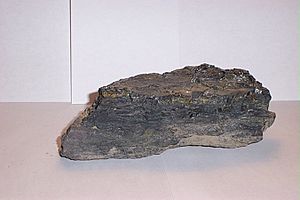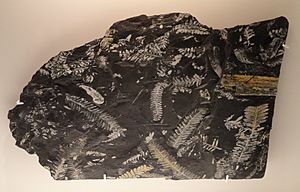Llewellyn Formation facts for kids
Quick facts for kids Llewellyn FormationStratigraphic range: Late Pennsylvanian ~300Ma |
|
|---|---|

A hand sample of the bottom of the Llewellyn from St. Clair, Pennsylvania
|
|
| Type | Sedimentary |
| Unit of | none |
| Sub-units | none (most economic coal beds are named) |
| Overlies | Pottsville Formation |
| Thickness | up to 1,500 feet (460 m) |
| Lithology | |
| Primary | Sandstone |
| Other | Shale, Conglomerate, Coal |
| Location | |
| Region | Appalachian Basin of eastern North America |
| Extent | Anthracite fields of Pennsylvania |
| Type section | |
| Named for | Llewellyn, Pennsylvania |
| Named by | G. Wood, 1964 |
The Llewellyn Formation is a special layer of rock found in eastern Pennsylvania. It was once called the "coal measures" because it contains a lot of coal. This rock formation is named after the town of Llewellyn in Schuylkill County.
Contents
What is the Llewellyn Formation made of?
The Llewellyn Formation is mostly made of gray rocks. These include sandstone (like hardened sand), siltstone (like hardened mud), shale (another type of hardened mud), conglomerate (rock with pebbles), and anthracite coal. These different rock types are found in repeating layers. While gray is the main color, you might also see buff, brown, or black rocks.
How did the Llewellyn Formation form?
The Llewellyn Formation began to form on a wide, flat plain. Rivers carried sand and mud from mountains nearby. Huge forests grew on this plain. When plants died, they were buried under layers of mud and sand. Over millions of years, this buried plant material turned into coal. The way these layers repeat tells scientists a lot about how the environment changed over time.
What fossils are found in the Llewellyn Formation?
Scientists have found almost 100 different types of fossils in the Llewellyn Formation. Most of these are plant fossils! Some of the main plant groups found include ancient lycopods, horsetails, ferns, and seed ferns. These fossils can be found in all the rock types, but they are most common in the siltstone, shale, and coal layers. Many of the plant fossils from the Llewellyn Formation are famous for their striking white color against the dark rock. A great place to find these fossils is near St. Clair, Pennsylvania.
Where can you see the Llewellyn Formation?
You can see parts of the Llewellyn Formation at places like the Bear Valley Strip Mine. This mine is located west of Shamokin in Northumberland County, Pennsylvania.
How old is the Llewellyn Formation?
The Llewellyn Formation is very old! Scientists believe it formed during the late Pennsylvanian Period. This means it was deposited about 300 to 308 million years ago. It was once thought that the very top layers might be from the Permian Period, but no fossils from that time have been found. The Llewellyn Formation is the last major rock layer from this ancient time that still exists in eastern Pennsylvania.
What is the economic use of the Llewellyn Formation?
The Llewellyn Formation has been very important for its coal. In the past, a lot of coal was mined from these rocks. The most coal was mined in 1917, with almost 100 million tons produced! Since then, coal production has gone down. Today, old mining waste (called culm) is sometimes re-processed to get more coal for power plants.



